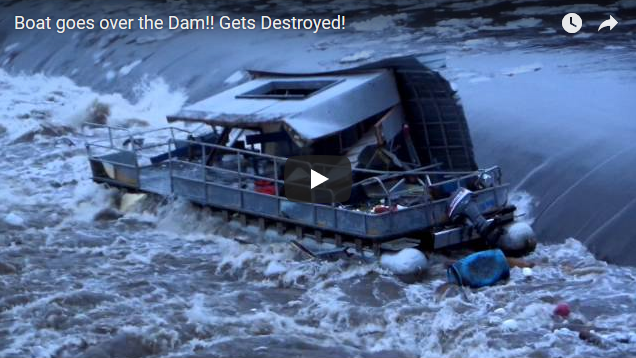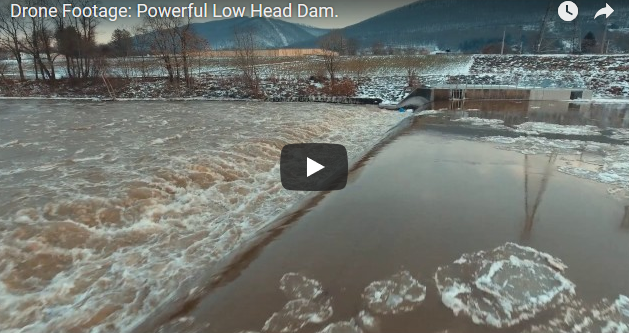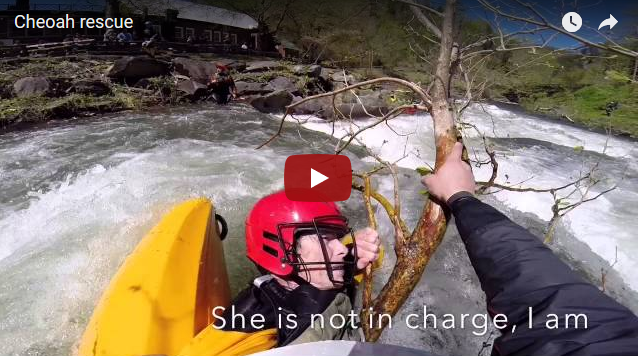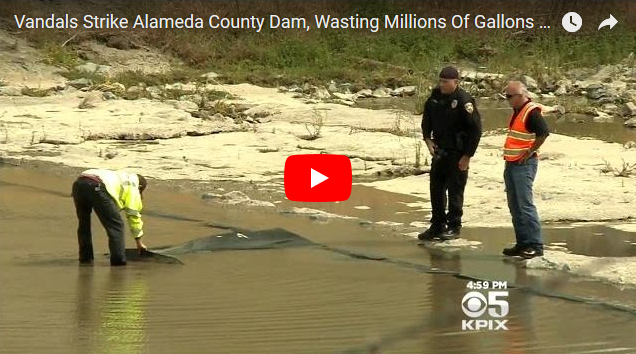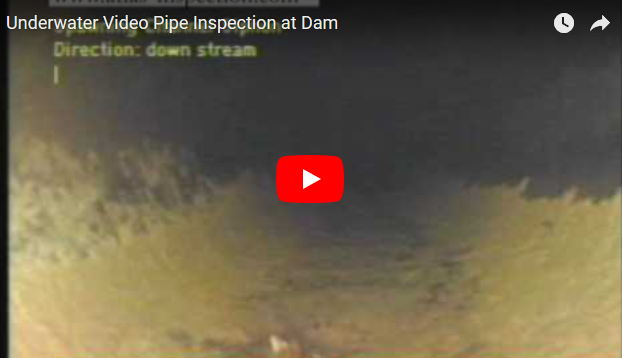Public Safety Hazards
Select an icon below to learn more about some of the more common hazards.
Hazards From Water Flows
Hydraulic Roller
The hydraulic roller is one of the most common and most lethal hazards of low-head dams. Under certain water conditions, a dangerous submerged hydraulic roller can form immediately downstream of a low-head dam. As the water flow crests and falls to the base of the dam, it creates a recirculating current that pushes anything caught in it to the bottom of the stream, dragging it along the stream bed, then releasing it up to the surface of the water, then sucking it back into the face of the dam. This circulation can keep people, boats, and other objects trapped for an extended amount of time, repeatedly slamming them against the dam wall. These forces are brutal and largely inescapable. The surface of the water can often appear to be calm, hiding the submerged dangers below.
The image demonstrates how the recirculating current forms and flows. As evidenced by the arrows, the best way to try and escape this current is by crawling or swimming along the bottom of the river and washing out the bottom of the hydraulic to a safe distance downstream. This may involve the difficult and dangerous, counterintuitive action of removing your life jacket while immersed in this ‘washing machine’ hydraulic. Unfortunately, this is oftentimes extremely difficult due to the strength of the currents, buoyancy of life jackets and the power and physically exhausting nature of the hydraulic. This is what makes the current so dangerous - it is extremely difficult to escape, both for humans and boats.
Additionally, while wearing a life jacket is essential and often contributes greatly to preventing drowning, it isn't always a guarantee of safety in these types of currents. Due to the way the water churns and aerates in a roller, air bubbles can decrease the buoyancy of the water by up to a third. It may, therefore, be difficult to stay afloat, even when wearing appropriate flotation devices. All of these factors combine to make hydraulic rollers perfect ‘keeper holes’ or ‘drowning machines’ that account for dozens of fatalities every year on our nation's waterways.
Finally, rescues and extractions from these hydraulics can be very hazardous to your outdoor partners, spectators or first responders and often result in multiple fatalities that include well-meaning good Samaritans trying to help in a very dangerous situation.
Swift Currents Over Spillways
Water flows over low-head dams and over dam spillways are particularly dangerous as they may be difficult to recognize and may not be visible from upstream, due to their low profile and false-horizon appearance. If the crest of the dam is left unmarked and unprotected, boaters in the reservoir can be drawn over the dam or spillway. Jet skiers, canoes, kayaks, and power boats have driven off the crest of low-head dams, unaware of the sudden drop, with tragic consequences. More often, motor boaters experience engine problems and lose control of their boats and are carried by the current over the edge.
If the width of the stream or reservoir narrows on the approach to a dam or spillway structure, the currents over the dam head will increase in velocity. This change in speed can catch people by surprise, drawing in swimmers, kayakers, canoers, and motor boaters towards the dam and over it before they have a chance to respond.
Before heading out on any waterway or body of water, it is critical to view a map (not all dams are indicated on maps, however), ask a local to point out hazards, look out for signage indicating hazards and dams (these are not always present), and always remain alert to the possibility of changes in currents near dam structures. It may be necessary to pull out a safe distance upstream and portage the hazard before re-entering the water a safe distance downstream away from the drop or hazardous hydraulic. Oftentimes people do not have time to get out of the water above the hydraulic or put back in the water too close to the hydraulic downstream and face catastrophic consequences.
Dam owners and operators should also be cognizant of these dangerous hydraulic hazards and mark the approaches to the dam and spillway entrances with signs, buoys or log booms.
Seepage and Strainers
Same dams will develop seepages or flows of water into or through the dam via cracks or joints over time. These water flows can draw objects from the river, including people, trees and plant matter, and trash to the face of the dam. These objects can become pinned against the face of the dam by the force of suction created by the water flowing through the dam. Additionally, the structure of dams is such that they will often catch river debris such as large fallen trees, animal dens, or large mats of plant material against the dam face and spillway crest or between piers. The force of currents moving through the trapped debris can pin a swimmer or diver against the blockage, creating a strainer that allows water to flow through but does not allow larger objects, such as humans, animals, or boats to pass through, raising the possibility of significant injury or death.
Always be alert to the possibility of large clusters of debris and give a wide berth to both the dam structure itself as well as to any floating hazards from trees, plants, and trash.
Unexpected Changes in Water Levels
Water levels on rivers, streams, and lakes can change quickly in a matter of hours or, in rare cases, even minutes. A number of potential factors can cause this ranging from changes in weather and rainfall to man-made releases of water. It is not always possible to anticipate changes in water level from previous rainfall, snowmelt, or other natural processes. As bodies of water change, the behavior of the water flows and currents change as well. Small changes in water level or flow can create different behaviors in the area of a dam, potentially creating unsafe conditions such as much swifter currents or even a hydraulic roller in areas that were previously safe. Just because a river was safe yesterday or even in that same morning, does not mean it will remain so.
Additionally, there are a number of reasons for man-made releases from upstream facilities. Industrial or manufacturing outputs may flush into a river, or an upstream dam may release some water. While some dam releases are preceded by a number of warnings including sirens, lights, and public announcement, it is always important to be aware of potential changes in water levels. Sudden changes can create fast moving and deadly floods or changes in behavior that can overwhelm unsuspecting people recreating or working downstream.
Hazards from Human Activities
Extreme Sports
People enjoy risky activities because they like the adrenaline rush it brings and showing off for their friends. There are many design features of dams and spillways that people believe they can take advantage of to get a thrill, without truly knowing the dangers involved. Unfortunately, the development of social media has only made the issue worse. Many major companies have used their prominent social media presence to share and promote unsafe activities around dams.
Whether it is white water kayaking over dams, biking along dam crests, skate-boarding, boogie-boarding or body-surfing through spillways, there are many thrill-seeking activities that have had tragic ends. These activities aren't only dangerous for the person involved, but if something goes wrong it can be a huge risk for first responders who are expected to go help in the event of an emergency. Additionally, misuse of these structures can lead to serious damage to the physical dam itself, with potentially catastrophic consequences. There is no thrill worth endangering yourself and certainly not worth risking the lives of our nation's first responders.
This photo shows a kayaker going over the crest of a dam spillway. This kind of activity puts them at an extremely high risk of being caught in a number of hazards, most critically the hydraulic current. While some kayakers pursue this kind of extreme thrill and consider themselves competent enough to handle the challenges and risks associated with passing through a dam, it is important to remember that nobody ever intends to drown - they are caught by surprise by the currents and hidden hazards near a dam. Always exit the river and portage when approaching a dam from either direction.
Playing in Spillways
Many people mistakenly see dams as safe and fun areas to swim or slide. In many cases, low-head dams and the structures surrounding them are tragically treated as water park rides. While some of these dams may look like slides or waterfalls to ride over, they should never be used as an attraction. They are attractive nuisances and are very dangerous. Swimming near them or over them presents many kinds of dangers, such as getting stuck in a hydraulic, colliding with structures at high velocity, getting trapped in the dam structures, having difficulty getting out and much, much more.
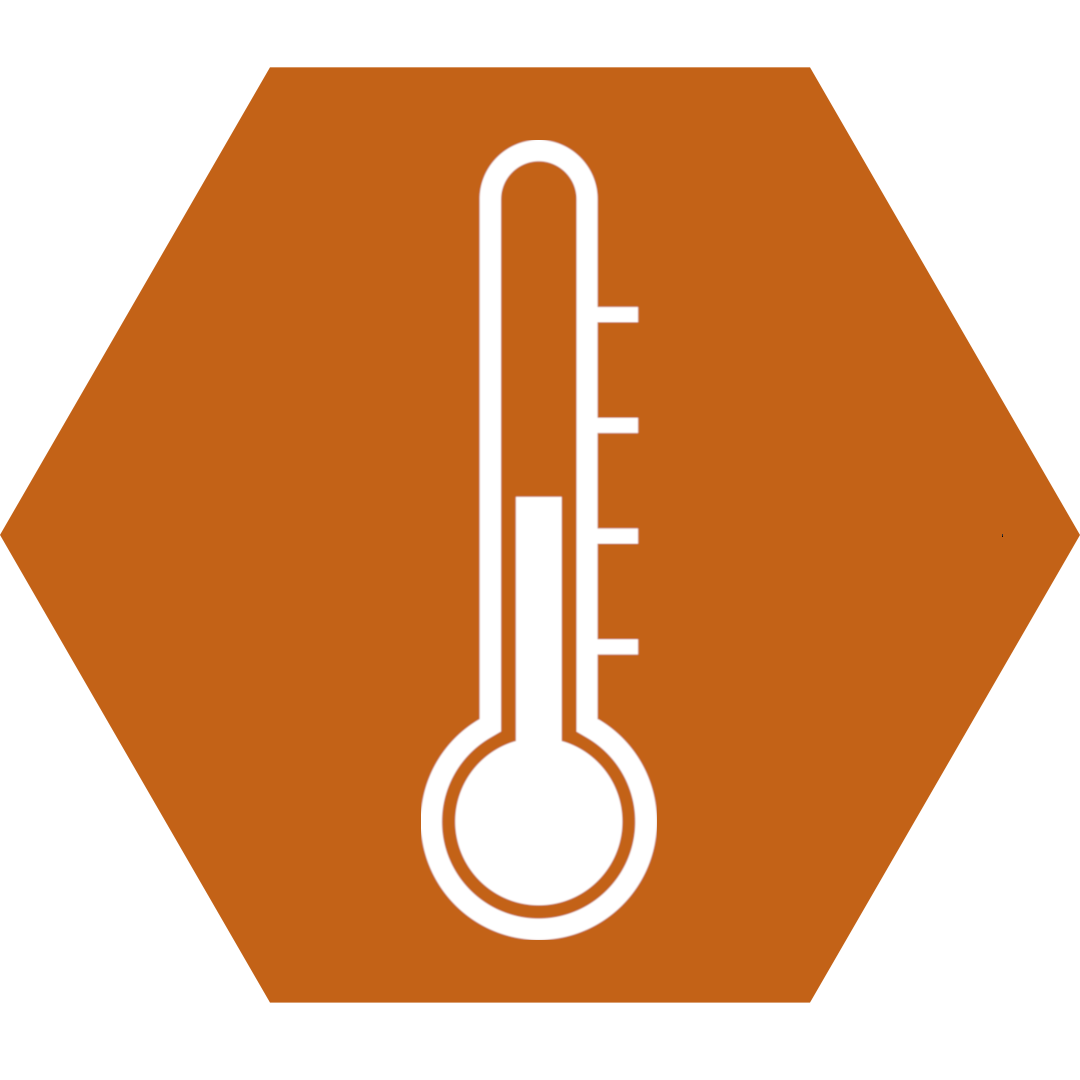 Entering the water around a dam also puts you at risk of hypothermia. In certain water conditions, it takes only a few minutes of exposure to cold temperatures before the body begins to suffer severe effects, such as a loss of motor functions, poor coordination, and slower mental functions. In many instances, you have five to ten minutes in cold water before you start to drown or cease to even care. Without appropriate rescue or treatment, the effects of this exposure can be fatal or result in lifelong damage.
Entering the water around a dam also puts you at risk of hypothermia. In certain water conditions, it takes only a few minutes of exposure to cold temperatures before the body begins to suffer severe effects, such as a loss of motor functions, poor coordination, and slower mental functions. In many instances, you have five to ten minutes in cold water before you start to drown or cease to even care. Without appropriate rescue or treatment, the effects of this exposure can be fatal or result in lifelong damage.
Jumping from Structures
Similarly, it's not uncommon for low-head dam structures to be misused as diving or jumping platforms. This presents the same significant risks as other recreational activities and could end with being caught in a hydraulic, being swept away downstream, being trapped against the face of the dam, and many others. Additionally, there are several risks associated with jumping or diving off of any structure, including a lack of awareness of the depth of the water below, the presence of subsurface hazards like rocks and submerged debris, as well as structures of the dam that could all cause injury if someone were to jump in to them. Miss-judging dam heights and water entrance angles and exponentially increasing free-fall velocities can be fatal. Again, it's important to always remember that while dams may serve many purposes, recreation is not among them.
Vandalism and Terrorism
Dams, both large and small, are easy and high-profile targets for vandalism and terrorism. Since many dams are easily accessible and their alteration or destruction can cause a lot of damage to people, structures, and the environment downstream, they are frequently at risk of being maliciously targeted by people ranging from local kids to organized groups. If you see or hear of anything amiss at a dam or know of any actions that would jeopardize the safety of a dam, report it immediately to dam, law enforcement or the Homeland Security authorities. The life you save may be your own. Dams are resilient and useful structures that provide a lot of benefits for many different stakeholders, as long as we respect them and allow them to function properly.
Hazards from Environmental Factors
Hidden Dams and Poor Visibility
Some dams, spillways, outlet works, pipes or other structures are not marked or are not above the water level, making them difficult to identify. If in moving water, it may be difficult or impossible to identify the hazard from upstream until it is too late to avoid it. Furthermore, on lakes, rivers, creeks and other bodies of water, water levels can vary over time, sometimes rapidly. Hazardous conditions may be present at some water levels/flow rates while not present at others. The best course of action is to be familiar with your planned route, the conditions of the waterway you intend to be on and the features that may potentially be hazardous along your intended route. If a particular feature is identified as potentially being hazardous, get out of the water and scout it before deciding whether to proceed, portage or avoid it.
Some hazards are particularly difficult to identify from the water. For example, water flowing over the crest of a dam or spillway (at the horizon line) can blend in to the downstream area when viewed from upstream. This condition is often difficult to perceive visually and there may be little to no audible noise warning of the hazard. Being aware of this condition is particularly important on rivers, creeks and swift flowing water as well as around low-head-dams.
Another hazard which is extremely difficult to identify from above the water are diversion or outlet works structures and culverts. These are often hidden below the water, or may be hidden behind overgrown bank vegetation. Furthermore, there is often little to no disturbance of the water surface when these are operating. These can create strong undercurrents within the main lake or creek, pulling a person into or against them. Strong suction forces associated with these features, can also make it difficult or impossible to escape from. These structures are best avoided and given a wide berth.
Additionally, many drownings and other incidents occur when swimmers and boaters go out on the water early in the morning or late at night, when light is low or when conditions are foggy and visibility is poor. Always make sure you are aware of your route, the presence of dams or other hazards along your route and only go out on the water in high visibility, safe conditions, if possible.
Poorly Marked Waterways
Oftentimes dams and spillways are not marked by signage on banks of the river or lakes, nor by buoys or lines demarcating exclusion zones. This can be due to a number of factors, from degradation (the signs have become overgrown or decayed), to lax regulation and enforcement, to owner oversight or negligence. Dams are also not always marked on traditional maps. In order to make sure you know your route, and are aware of potential hazards, seek out detailed maps and aerial photos that show hazards and attributes of waterways, talk to local water recreation groups and guides or government sources, and most of all - remain alert and prepared for the unexpected.
Animals and Insects
Dams are often perfect structures for animal habitats. Holes, crevices, burrows, deeper water and diminished currents all contribute to suitable homes for rodents and snakes as well as fish, alligators and crocodiles, beavers, and many other animals commonly found near waterways. These animals are dangers to both people and dam structures. If you are swimming, boating, or recreating in the area of a dam, be aware of the potential for aggressive or territorial animals.
Fish and Fauna Passages
Many dams and spillways are equipped with structures such as fish ladders or passages to allow for the freer movement of fauna or livestock through the stream. Unfortunately the design of these structures can at times make them attractive for people to play in, engage in extreme sports activities, or otherwise misuse. These are both delicate structures and dangerous structures. They pose considerable slipping and drowning hazards due to currents and animal activity. Like any other dam structure, these areas should be avoided.
Hazards from Dam Structures
Slippery Surfaces
Dams and spillways are not designed to have people walking across them. Additionally, the fact that they are frequently submerged, at least partially, leads to the growth of moss and algae on dam structures. These attributes lead to the creation of slip hazards along low head dam crests, spillways, and other structures. Submerged, low head dams should never be used as a bridge to cross a body of water, as they are not designed to serve as such and this activity can lead to severe injuries or drownings. If the area of a dam has signs restricting access to the dam or prohibiting climbing, jumping, or diving, always obey the posted signs. If there is no signage present, it is still wise to avoid walking or standing on submerged dam structures.
Flows Through Gated Structures
In addition to dangerous flows entering conduits, head-gate structures near entrances to locks, spillways and intake structures create hazards as water flows under or through the gate openings. An undercurrent, undertow, or sudden and unexpected release of water can occur when the gates are raised, especially if done under remote or automatic control. This hydraulic hazard is most commonly found at locks, gated spillways, and intake structures. We never fail to underestimate the power and persistence of flowing and standing water.
On June 19 of 2016 at the Melvin Price Lock and Dam in Alton, Illinois, a man was knocked off his jet ski near the upstream face of the dam on the Mississippi River when he hit a floating log. Even though he was wearing a life jacket, the man and his jet ski were subsequently sucked down through the gate opening about 17 feet below the water surface before resurfacing on the opposite side of the dam. He was rescued nearly one half of a mile downstream. Although he was physically exhausted from the ordeal, he was fortunate and suffered only minor injuries as a result of the incident. Many others are not as fortunate. Stay clear of locks and gates on waterways.
 Flows Into Conduit Openings
Flows Into Conduit Openings
Typically a feature associated with larger dams but present at many different sizes and types of dams includesconduits and outlets that allow water to flow in a controlled manner from one side of a dam to the other. These outlets, such as the one shown here from Harriman Dam, create dangerous undercurrents with powerful suction at the inlet that can trap and drown someone as they move through the conduit. These are extremely dangerous structures, but their dramatic appearance has led to a number of viral videos - most notably the morning glory or spillway at Monticello Dam in California - that in turn have led to thrill seekers and extreme athletes seeking them out, at times with tragic results. The currents around and within these structures are impossible to escape and are almost guaranteed to end in serious injury or death.
Confined Spaces
Dams of all types, from the largest gravity dams to the smallest low head dams, may have areas of confined space. These structures include everything from overhangs to tanks, tunnels, manholes, conduits, pipes, pits, and ductwork. Because of the small nature of these spaces, objects and people can easily become wedged, especially if water flows into or around the space. These confined areas are especially hazardous for smaller children and should not be entered or approached except by qualified dam inspectors and professionals.
These spaces may also contain hazardous gasses may be odorless and colorless or undetectable but can create an area of low oxygen where you can suffocate, pass out quickly and expire if you are not rescued. This creates another hazardous zone for the rescuers and first responders to navigate. There are many governmental regulations (OSHA, MSHA) for confined spaces that should be researched and respected by dam professionals and the public before entering these places.
